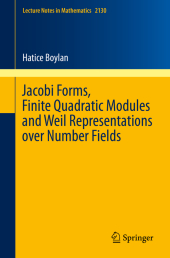 Neuerscheinungen 2014Stand: 2020-02-01 |
Schnellsuche
ISBN/Stichwort/Autor
|
Herderstraße 10
10625 Berlin
Tel.: 030 315 714 16
Fax 030 315 714 14
info@buchspektrum.de |

Hatice Boylan
Jacobi Forms, Finite Quadratic Modules and Weil Representations over Number Fields
2015. 2014. xix, 130 S. 3 Tabellen. 235 mm
Verlag/Jahr: SPRINGER, BERLIN; SPRINGER INTERNATIONAL PUBLISHING 2014
ISBN: 3-319-12915-5 (3319129155)
Neue ISBN: 978-3-319-12915-0 (9783319129150)
Preis und Lieferzeit: Bitte klicken
The new theory of Jacobi forms over totally real number fields introduced in this monograph is expected to give further insight into the arithmetic theory of Hilbert modular forms, its L-series, and into elliptic curves over number fields. This work is inspired by the classical theory of Jacobi forms over the rational numbers, which is an indispensable tool in the arithmetic theory of elliptic modular forms, elliptic curves, and in many other disciplines in mathematics and physics. Jacobi forms can be viewed as vector valued modular forms which take values in so-called Weil representations. Accordingly, the first two chapters develop the theory of finite quadratic modules and associated Weil representations over number fields. This part might also be interesting for those who are merely interested in the representation theory of Hilbert modular groups. One of the main applications is the complete classification of Jacobi forms of singular weight over an arbitrary totally real number field.
Introduction.- Notations.- Finite Quadratic Modules.- Weil Representations of Finite Quadratic Modules.- Jacobi Forms over Totally Real Number Fields.- Singular Jacobi Forms.- Tables.- Glossary.
"The classical theory of Jacobi forms, and its connections to elliptic modular forms, have been a constant subject of research for many decades. ... this book is valuable contribution to the mathematical society, and serves as a welcoming invitation to anyone who finds interest in engaging him/herself in researching this beautiful new theory." (Shaul Zemel, zbMATH 1317.11002, 2015)


